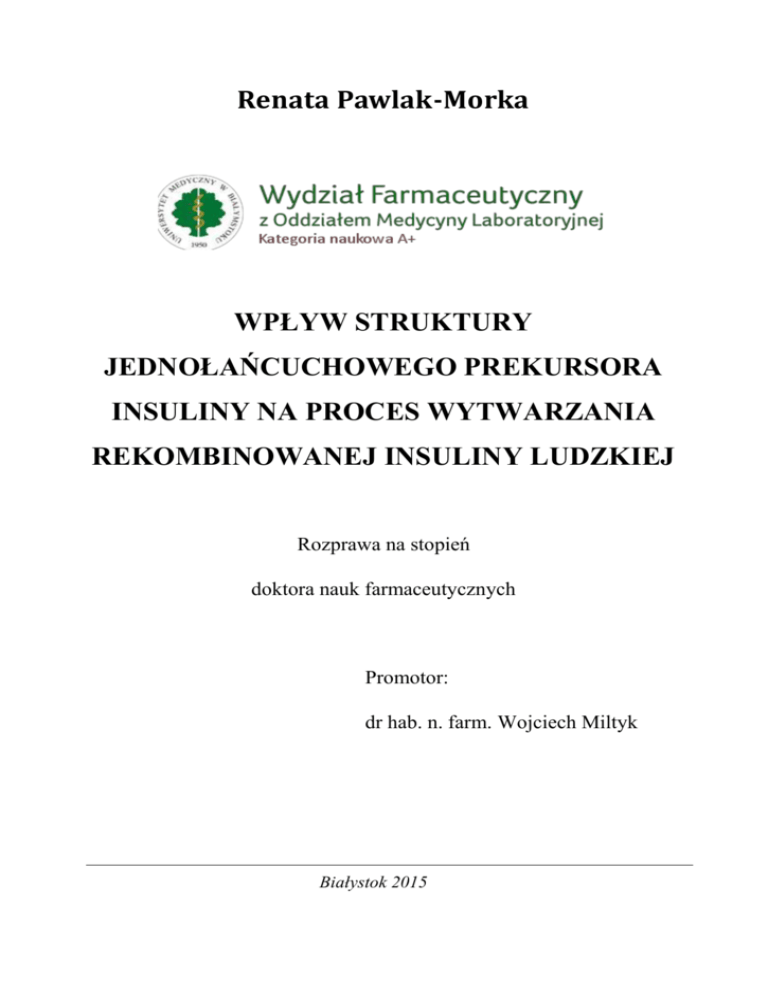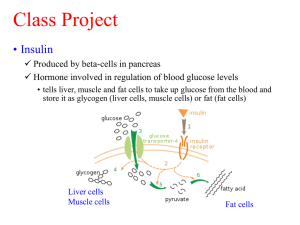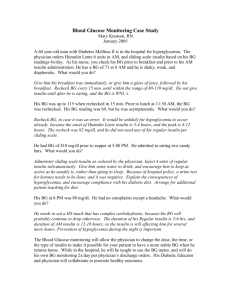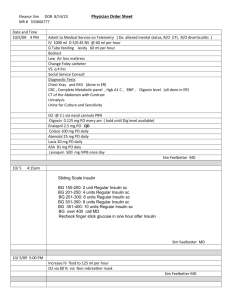Renata Pawlak-Morka WPŁYW STRUKTURY
advertisement

Renata Pawlak-Morka WPŁYW STRUKTURY JEDNOŁAŃCUCHOWEGO PREKURSORA INSULINY NA PROCES WYTWARZANIA REKOMBINOWANEJ INSULINY LUDZKIEJ Rozprawa na stopień doktora nauk farmaceutycznych Promotor: dr hab. n. farm. Wojciech Miltyk Białystok 2015 Abstract VIII. ABSTRACT Human insulin is a polypeptide hormone secreted by the pancreatic β cells. This hormone plays a key role in the regulation of blood glucose levels and is composed of two chains: A (21 amino acids) and B (30 amino acids) covalently linked by two disulfide bridges, the third disulfide bridge is the internal structure of chain A and determines its form. Recombinant human insulin manufacturing process, being the subject of the research, is based on a genetically modified bacteria strain of E. coli containing the plasmid with the single chain human insulin precursor DNA coding fragment. The DNA sequence encoding the precursor contains a modified gene fragment of human superoxide dismutase Cu / Zn (SOD) responsible for the efficiency and reconstruction of higher order structures. In order to receive the active form of the hormone - recombinant human insulin is correct dissolution of the inclusion bodies and then reconstruction of the structure characteristic for the protein present in the human body. The aim of the study was to evaluate the effect of the primary structure of human insulin precursor on the manufacturing process and the characteristics of the received active substance - recombinant human insulin. In order to assess the role of the precursor in the first stage a detailed structural analysis confirming the amino acid sequence of a single chain precursor was performed. For the evaluation the Edman degradation and MALDI TOF techniques were used. In the second stage a detailed analysis for the folding process and protein material obtained as a result of enzymatic conversion was performed. Based on the above data, the impact of the precursor structure on the active substance manufacturing process was assessed. For evaluation two analytical methods based on high pressure liquid chromatography (HPLC) were used. In the third, final and crucial stage of the study the active ingredient was evaluated. For the quality evaluation infrared spectroscopy as used, which is one of the most comprehensive research techniques which allows to view the secondary structure of proteins and changes caused by various external factors. Additionally the secondary structure study was confirmed by circular dichroism. In accordance with the recommendation of the European Medicinal Agency for the final evaluation of the biological activity the binding of insulin to human insulin receptor fragment and to the insulin-like growth factor I (IGF-IR) measurements were used. The studies identified and confirmed the primary structure of the single-chain Abstract precursor used in the production of recombinant human insulin. In the course of the analysis demonstrated that identified structure of the insulin precursor provides correct and repeatable folding process and enzymatic conversion of protein. Structural and biological compatibility between tested insulin and reference substance was observed. Obtained results extend the knowledge on manufacturing processes for protein substances producing by recombination technology, mechanisms that occur during and the effect of the primary structure of starting materials such as insulin single chain precursor on the quality of the active substances used in the treatment of diabetes mellitus type I and II.








